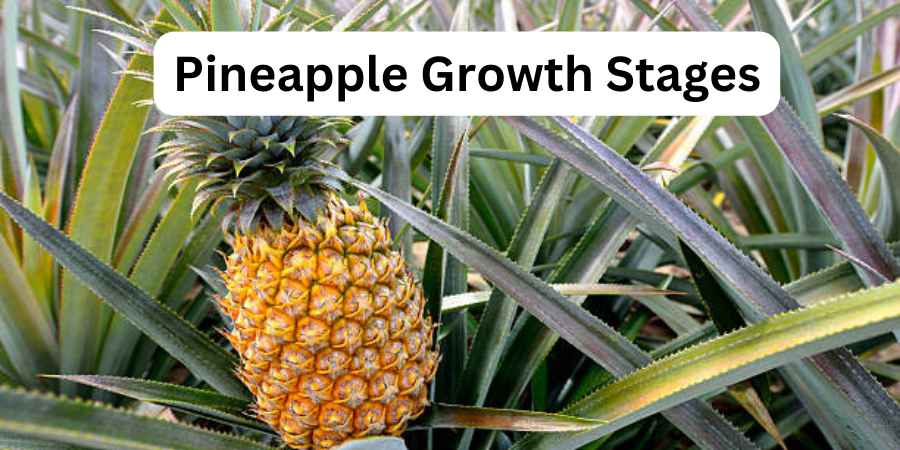Last Updated on June 25, 2025 by Jocelyn
Pineapples grow through different steps that take about 18 to 24 months. It all starts when you plant a crown, a sucker, or a slip. In about 6 to 8 weeks, roots begin to grow.
Then the plant grows more leaves that look like a big green circle. After 16 to 24 months, the plant starts to grow tiny purple flowers in the center. These flowers stick together and slowly become one pineapple.
The fruit keeps growing for 5 to 6 more months. When it turns golden yellow and smells sweet, it is ready to pick.
Most pineapple plants grow one fruit, but they can also grow more fruits from small side shoots.
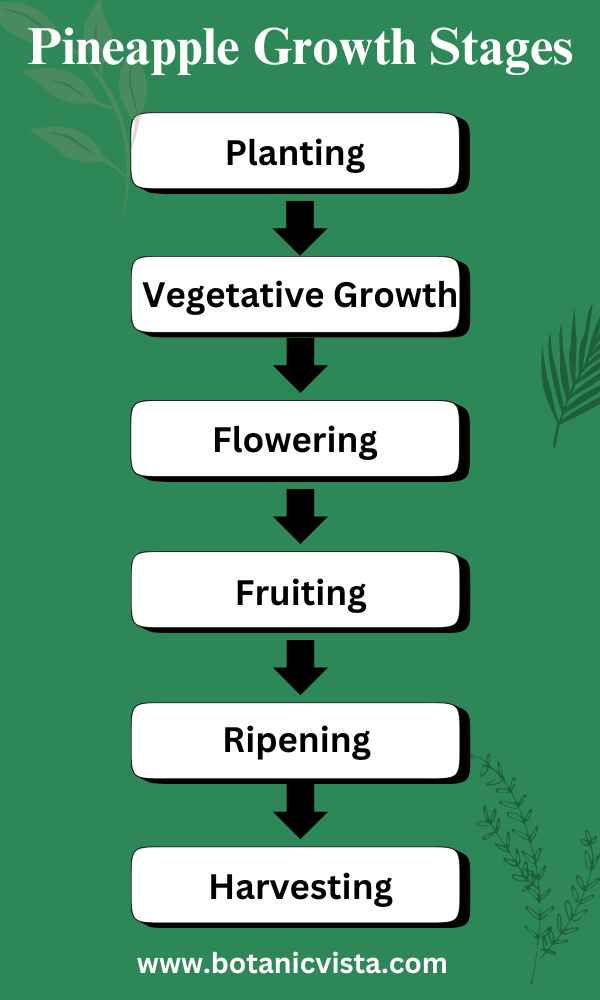
Table of Contents
TogglePineapple Growth Stages – From Planting to Perfect Fruit
Growing pineapples is a fascinating process that anyone can enjoy. Whether you have a backyard garden or small indoor pots, learning the steps to cultivate this delicious fruit is incredibly fun.
Let’s explore the pineapple growth process together.
Planting Phase
When planting a pineapple, start with a healthy top. Cut the crown off the fruit and let it dry for a few days to prevent disease. Use soil that is moist but well-draining, enriched with chopped material from previous crops.
After 6 to 8 weeks, roots will develop. Place the pineapple in a pot where it gets enough sunlight. This setup helps the plant grow from a tiny top to a strong plant.
Slips and suckers are another effective method for planting pineapples. These grow from the base of established plants and can be carefully removed and planted.
Growers often prefer this method because it’s quicker and results in uniform fruits.
Ratoon crops come from the same plant after the first fruits are harvested. This allows for continuous production without needing to replant.
The second batch of fruits from the pineapple is often even sweeter and maintains the fruit characteristics.
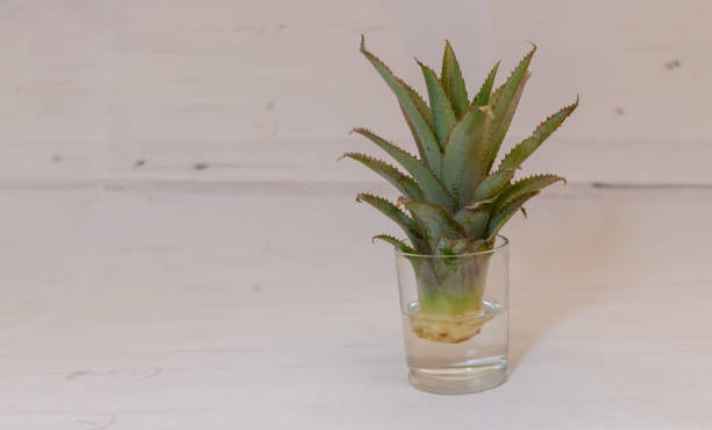
Vegetative Growth Phase
In the vegetative growth phase, a pineapple starts by growing roots and leaves. It needs proper soil and adequate nutrients. The leaf is green, smooth, and waxy, which helps it absorb moisture.
The environment is crucial. The pineapple must acclimate to its conditions for healthy development.
Suckers grow from the rooted plant, helping in future pineapple production. Each leaf needs adequate nutrients and moisture to stay green and long.
The spiny top supports growth in its environment. Rich soil and nutrients keep the plant healthy. Stable conditions with adequate water and waxy leaves ensure a well-rooted pineapple.
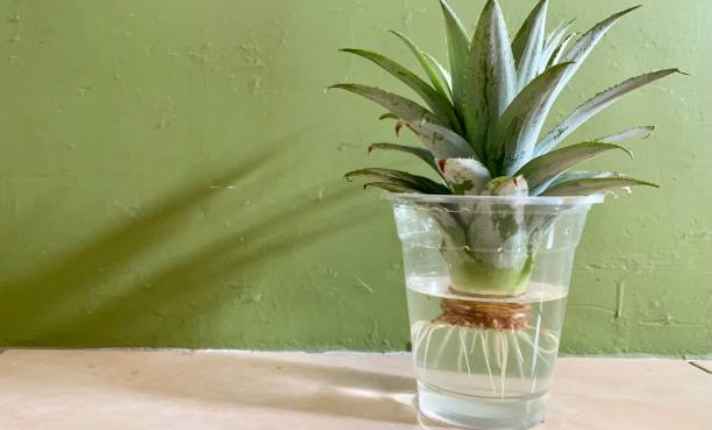
Flowering and Fruiting
Pineapples grow in warm climates. Growers often need ethylene to help the plant start flowering. Flower buds appear in the center of the pineapple and look like tiny flowers. Each flower will form a fruitlet.
In 200 days, flowering begins. The inflorescence has spiky bracts that surround the flowers. Pollination happens naturally, but it can be tricky.
The ovary of each flower develops into a berry. These berries fuse together to form a syncarp or single fruit.
The fruit goes through a phase called ripening. During this time, the pineapple grows and changes color. This process takes about 6 months.
A commercial farm will encourage this by controlling the temperature and using chemical solutions.
Each eye on the pineapple is a flower that has fused into the syncarp. The timeline for a pineapple from flowering to ripening is 16 to 24 months. Ethylene helps ripen the fruit faster.
Pineapples are spiky on the outside and sweet on the inside. They are often called the “king of fruits” due to their long growing timeline and unique taste.
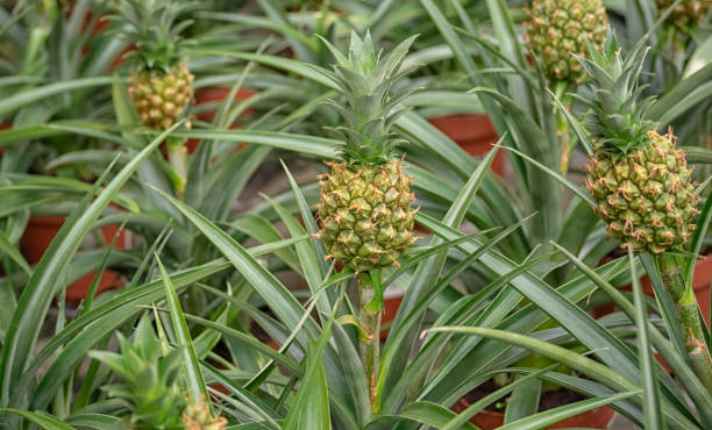
Ripening and Harvesting
To harvest pineapples, wait for the right temperature and use shears. Handle the delicate fruit with care. A ripe pineapple has a sweet aroma and yellow color.
Determine ripeness by gently pressing the fruit. If soft, it’s ready for consumption. High sugar content is a good sign, and use a knife to cut it, avoiding damage. Look for a strong aroma and golden-yellow skin as indicators.
Check the stem for a sweet smell. As it grows, the color changes. For shopping, choose those with a yellow base. At home, store them at room temperature. The crop should be at its peak Brix level when harvested.
Ripening begins at the base and moves up. Monitor your pineapples weekly. The flower turns into fruit in about six months. Harvest when fully ripe to avoid damage.
For home-grown pineapples, check the fruit for a sweet aroma before cutting. The golden-yellow color is the best indicator.
Gently press the pineapple to check ripeness. During processing, handle carefully to avoid damage. Store properly to maintain quality. Weekly checks ensure the best crop.
Use a knife to remove the pineapple from the stem. Enjoy pineapples fresh, right after harvesting. Processing can start immediately after harvesting. Store extras at room temperature for the best flavor.
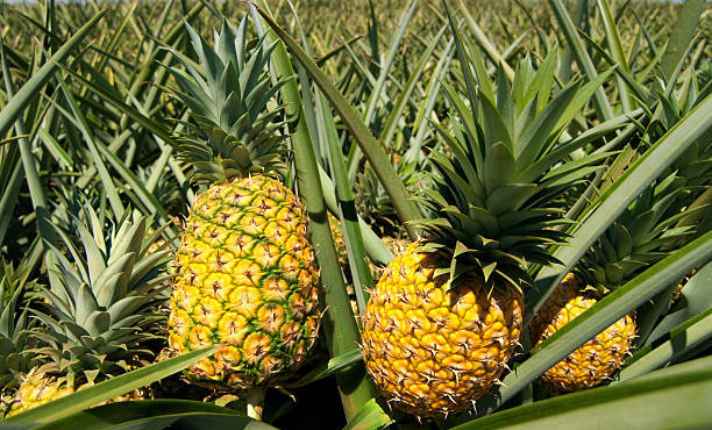
Factors Influencing Pineapple Growth Time
Growing pineapples involves understanding several key factors. From soil conditions to climate, each element plays a vital role in the growth and fruit quality of pineapple plants.
1. Soil Conditions
Pineapples need well-draining soil to grow well. Loamy soil with good soil structure and pH balance is best. They prefer a pH of 4.5 to 6.5. Adding compost and well-rotted manure can help improve soil fertility.
2. Moisture and Irrigation
Proper irrigation practices are crucial. Avoid waterlogging, which can cause root rot. During dry periods, ensure deep watering to encourage deep root growth.
3. Nutrient Management
Balanced fertilization is key for healthy pineapple plants. Use nitrogen, phosphorus, and potassium to address nutrient deficiencies. Regular soil testing can help guide fertilizer application.
4. Climate and Temperature
Pineapples grow best in tropical and subtropical climates with a stable temperature range of 60°F (15°C) and 95°F (35°C). Avoid extreme temperature fluctuations and cold temperatures to prevent pineapple wilt and poor fruit production.
5. Pest and Disease Control
Pest management involves targeted pesticide use to control insect pests like mealybugs. Good cultural practices and pest control methods help prevent diseases and pineapple wilt.
FAQ’s
Q: How Long Does It Take for a Pineapple Plant to Grow?
A: Pineapple plants bear fruit in several stages. First, they need to be started from seeds or a crown. This process takes about 18 months.
After the first fruiting, the plant continues to produce fruit at regular intervals. Roughly every two years, the pineapple plant will bear another edible fruit.
Seedlings mature at different speeds. Some pineapples may bear fruit within three years, while others take up to five years.
Q: What Is the Growth Cycle of a Pineapple?
A: Pineapples go through a detailed growth cycle. After planting, the plant takes about 15 months to develop flowers. This period varies depending on the type of pineapple and prevailing conditions.
Once the flower appears, it takes another 6 months for the fruit to mature. The fruit is usually ready for harvest 12 to 18 months after planting.
During this time, the size of the fruit depends on the type of pineapple plant and prevailing conditions. The best time for harvest is during August and May.
Q: How Many Pineapples Grow on One Plant?
A: One plant produces just a single pineapple. After the first pineapple is produced, the plant makes pups – new little plants at the base that can grow more pineapples.
Q: Can You Cut the Top off a Pineapple and Replant It?
A: Yes, you can. After chopping the top off a pineapple, don’t toss it away. Once you’ve removed the remnants of the fruit correctly, plant it to grow another one.
Q: What to Do if the Pineapple Falls off the Plant?
A: If a pineapple falls off the plant, place it in loose soil and water it regularly. In summer, give it more water to help it grow larger and stronger.
Conclusion
Growing pineapples takes about two years. Start with a pineapple top, not seeds. Place it in warm sunlight. Water it regularly but avoid soggy soil. Watch for pests that can harm the plant.
I planted a pineapple top in my garden. Seeing it grow into fruit was a great experience. This journey shows the beauty of nature and gardening.
For more gardening tips, explore more on growing pineapples. Discover easy ways to grow your own fruits today!
Also read:
